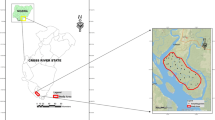Abstract
Utilizing soil electrical conductivity (EC) measurements and terrain attributes for precision management will require secondary soil information for adequate interpretation. The objective of this study was to determine whether readily available second-order soil surveys were of adequate quality to aid with interpreting soil EC and terrain data. For three locations in Kentucky, USA, first-order soil surveys were created, second-order surveys reports were obtained, elevation was measured and used to calculate terrain attributes (slope, aspect, plan curvature, profile curvature), and bulk soil electrical conductivity was measured. Three analytical methods (an ordinary least squares analysis and two random field analyses), visual map assessment, and examination of least-squares means were used to assess the relationships between soil EC measurements, terrain attributes and first- and second-order soil surveys. The OLS and random field analyses were problematic. However, the ranking of the OLS F-statistics appeared to reflect the general relationship between landscape variables and first-order soil surveys. The landscape variables related particularly well with soil properties that had been impacted by past soil erosion. Unfortunately, however, second-order soil surveys in this study were not created at suitable scales to adequately interpret EC and terrain data regarding erosion history or other attributes. While these surveys may provide some useful information, field measurements, sampling, and observations will likely be required to develop high quality interpretations of soil EC and terrain attribute data.
Similar content being viewed by others
References
Bell, J. C., Butler, C. A. and Thompson, J. A. 1995. Soil-terrain modeling for site-specific agricultural management. In: Site-Specific Management for Agricultural Systems, edited by P. C. Robert, R. H. Rust, W. E. Larson (ASA Misc. Publ., ASA, CSSA, and SSSA, Madison, WI, USA), p. 209-227.
J. C. Bell R. L. Cunningham M. W. Havens (1992) ArticleTitleCalibration and validation of a soil-landscape model for predicting soil drainage class Soil Science Society of America Journal 56 1860–1866
H. Bourennane D. King P. Chery A. Bruand (1996) ArticleTitleImproving the kriging of soil variables using slope gradient as external drift European Journal of Soil Science 47 473–483
N. Cressie D. M. Hawkins (1980) ArticleTitleRobust estimation of the variogram Mathematical Geology 12 115–125
J. A. Doolittle K. A. Sudduth N. R. Kitchen S. J. Indorante (1994) ArticleTitleEstimating depths to claypans using electromagnetic induction methods Journal of Soil and Water Conservation 49 572–575
R. D. Hammer F. J. Young N. C. Wollenhaupt T. L. Barney T. W. Haithcoate (1995) ArticleTitleSlope class maps from soil survey and digital elevation models Soil Science Society of America Journal 59 509–519
R.G. Kachanoski E. G. Gregorich I. J. Van Wesenbeeck (1988) ArticleTitleEstimating spatial variations of soil water content using non-contacting electromagnetic inductive methods Canadian Journal of Soil Science 68 715–722
N.R. Kitchen K. A. Sudduth S. T. Drummond (1996) ArticleTitleMapping of sand deposition from Midwest floods with electromagnetic induction measurements Journal of Soil and Water Conservation 51 336–340
A. N. Kravchenko G. A. Bollero R. A. Omonode D. G. Bullock (2002) ArticleTitleQuantitative mapping of soil drainage classes using topographical data and soil electrical conductivity Soil Science Society of America Journal 66 235–243
R. C. Littell G. A. Milliken W. W. Stroup R. D. Wolfinger (1996) SAS System for Mixed Models SAS Institute Cary NC, USA
R. A. McBride A. M. Gordon S. C. Shrive (1990) ArticleTitleEstimating forest soil quality from terrain measurements of apparent electrical conductivity Soil Science Society of America Journal 54 290–293
I. D. Moore P. E. Gessler G. A. Nielsen G. A. Peterson (1993) ArticleTitleSoil attribute prediction using terrain analysis Soil Science Society of America Journal 57 443–452
T. G. Mueller N. J. Hartsock T. S. Stombaugh S. A. Shearer P. L. Cornelius R. I. Barnhisel (2003) ArticleTitleSoil electrical conductivity map variability in limestone soils overlain by loess Agronomy Journal 95 496–507
J. D. Rhoades R. D. Ingvalson (1971) ArticleTitleDetermining salinity in field soils with soil resistance measurements Soil Science Society of America Proceedings 35 54–60
P. Robert (1993) ArticleTitleCharacterization of soil conditions at the field level for soil specific management Geoderma 60 57–72
O. Schabenberger F. J. Pierce (2002) Contemporary Statistical Models for the Plant and Soil Sciences CRC Press LLC, Boca Raton FL, USA
Soil Survey Division Staff. 1993. Soil Survey Manual. (Soil Conservation Service. U.S. Department of Agriculture Handbook 18, Washington, DC). Available on line at http://soils.usda.gov/technical/manual/.
USDA-NRCS. 2003a. List of Printed soil Surveys by State. Available on-line at http://soils.usda.gov/survey/printed_surveys/.
USDA-NRCS. 2003b. Official Soil Series Descriptions Data Access. Available on-line at http://ortho.ftw.nrcs.usda.gov/osd/osd.html.
USDA-SCS. 1973. Soil Survey of Calloway and Marshall Counties, KY, USA.
USDA-SCS. 1979. Soil Survey of Hardin County, KY, USA.
USDA-SCS. 1980. Soil Survey of Shelby County, KY, USA.
B. G. Williams D. Hoey (1987) ArticleTitleThe use of electromagnetic induction to detect the spatial variability of the salt and clay contents of soil Australian Journal of Soil Science 25 21–27
Author information
Authors and Affiliations
Corresponding author
Rights and permissions
About this article
Cite this article
Hartsock, N.J., Mueller, T.G., Karathanasis, A.D. et al. Interpreting Soil Electrical Conductivity and Terrain Attribute Variability with Soil Surveys. Precision Agric 6, 53–72 (2005). https://doi.org/10.1007/s11119-004-0684-x
Issue Date:
DOI: https://doi.org/10.1007/s11119-004-0684-x




